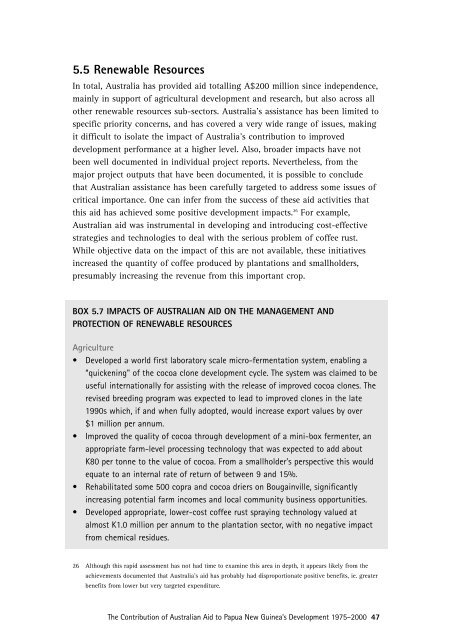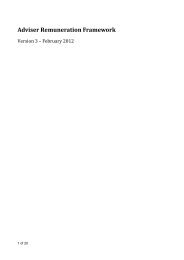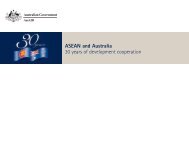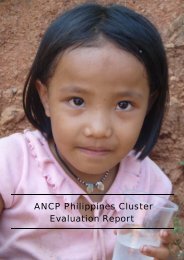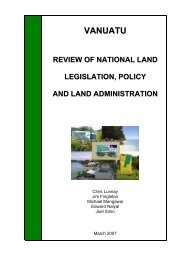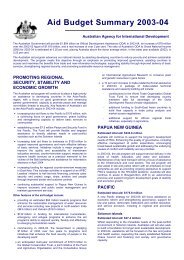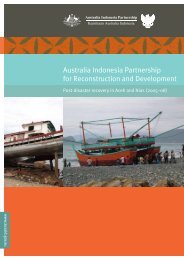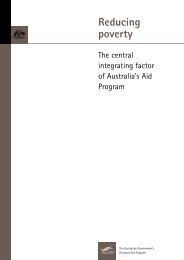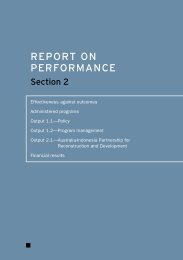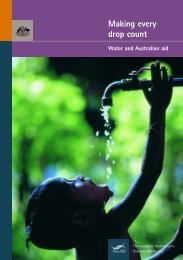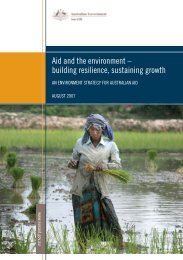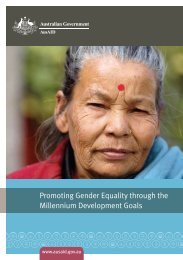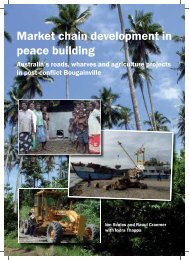Australian Aid to PNG - AusAID
Australian Aid to PNG - AusAID
Australian Aid to PNG - AusAID
Create successful ePaper yourself
Turn your PDF publications into a flip-book with our unique Google optimized e-Paper software.
5.5 Renewable ResourcesIn <strong>to</strong>tal, Australia has provided aid <strong>to</strong>talling A$200 million since independence,mainly in support of agricultural development and research, but also across allother renewable resources sub-sec<strong>to</strong>rs. Australia’s assistance has been limited <strong>to</strong>specific priority concerns, and has covered a very wide range of issues, makingit difficult <strong>to</strong> isolate the impact of Australia’s contribution <strong>to</strong> improveddevelopment performance at a higher level. Also, broader impacts have notbeen well documented in individual project reports. Nevertheless, from themajor project outputs that have been documented, it is possible <strong>to</strong> concludethat <strong>Australian</strong> assistance has been carefully targeted <strong>to</strong> address some issues ofcritical importance. One can infer from the success of these aid activities thatthis aid has achieved some positive development impacts. 26 For example,<strong>Australian</strong> aid was instrumental in developing and introducing cost-effectivestrategies and technologies <strong>to</strong> deal with the serious problem of coffee rust.While objective data on the impact of this are not available, these initiativesincreased the quantity of coffee produced by plantations and smallholders,presumably increasing the revenue from this important crop.BOX 5.7 IMPACTS OF AUSTRALIAN AID ON THE MANAGEMENT ANDPROTECTION OF RENEWABLE RESOURCESAgriculture• Developed a world first labora<strong>to</strong>ry scale micro-fermentation system, enabling a“quickening" of the cocoa clone development cycle. The system was claimed <strong>to</strong> beuseful internationally for assisting with the release of improved cocoa clones. Therevised breeding program was expected <strong>to</strong> lead <strong>to</strong> improved clones in the late1990s which, if and when fully adopted, would increase export values by over$1 million per annum.• Improved the quality of cocoa through development of a mini-box fermenter, anappropriate farm-level processing technology that was expected <strong>to</strong> add aboutK80 per <strong>to</strong>nne <strong>to</strong> the value of cocoa. From a smallholder's perspective this wouldequate <strong>to</strong> an internal rate of return of between 9 and 15%.• Rehabilitated some 500 copra and cocoa driers on Bougainville, significantlyincreasing potential farm incomes and local community business opportunities.• Developed appropriate, lower-cost coffee rust spraying technology valued atalmost K1.0 million per annum <strong>to</strong> the plantation sec<strong>to</strong>r, with no negative impactfrom chemical residues.26Although this rapid assessment has not had time <strong>to</strong> examine this area in depth, it appears likely from theachievements documented that Australia’s aid has probably had disproportionate positive benefits, ie. greaterbenefits from lower but very targeted expenditure.The Contribution of <strong>Australian</strong> <strong>Aid</strong> <strong>to</strong> Papua New Guinea’s Development 1975–2000 47


